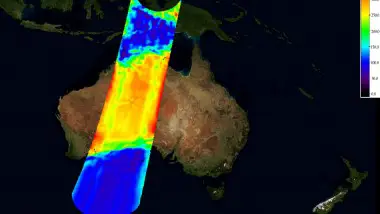Scientists at Sandia National Laboratory in Albuquerque, New Mexico have been testing Xilinx reprogrammable FPGAs attached to the International Space Station to ensure they operate properly amid the radiation, particle strikes, and other hazards of space. The certification process is ...
Bully Galaxy Rules the Neighborhood
NASA astronomers are using an image of a galaxy named ESO 306-17 to learn more about the formation of star groups, galaxies and celestial events. Since this galaxy is relatively separated from other observable objects, researchers are able to see ...
Disease May Derail Space Travel
Researchers at Nancy University in Lorraine, France have raised concerns that disease will make it impossible to support long-term space travel such as manned missions to Mars. Space travel both weakens the immune system and promotes more virulent growth of ...
Images from SMOS Arrive
The first callibrated images from the European Space Agency’s Soil Moisture and Ocean Salinity (SMOS) Satellite are available less than four months from the satellite’s launch. As the mission name implies, these images provide information on global soil moisture and ...
SARA Orbiter Advances
Scientists using the European Space Agency’s Sub-keV Atom Reflecting Analyzer (SARA) instrument aboard India’s Chandrayaan-1 Lunar Orbiter have determined how water could be created on the lunar surface. In addition, the same discovery could lead to an entirely new mechanism ...
Explaining Blue Stragglers’ Youthful Appearance
Astronomers from the University of Wisconsin-Madison have recently published an article that sheds light over the ‘youthful’ appearance of stars known as blue stragglers. These shiny stars, which seem older than they are, have puzzled scientists for almost 50 years; ...
The Source of Cosmic Microwave Background
Researchers at Max Planck Institute for Extraterrestrial Physics and other institutions have used data from the Herschel Space Telescope to resolve a portion of the Cosmic Microwave Background (CMB) into its constituent sources. Using images in the far infrared range ...
Avatar’s Moon Pandora Could Be Real
NASA’s Kepler mission has excited the imagination of many astronomers, when it showed recently the potential to detect Earth-sized objects and habitable moons. In a new paper, researcher from the Harvard-Smithsonian Center for Astrophysics suggests that stellar objects could have ...
Spitzer Telescope Observes Baby Brown Dwarf
NASA has recently released images of a baby brown dwarf, captured by the Spitzer Space Telescope. The object, which is a unique kind of a star, might be the youngest brown dwarf ever observed; therefore, scientists hope it could shed ...
Allen Telescope Array Delivers First Results
Researchers at the Allen Telescope Array in northern California have released the first results from the observatory. The most important images captured show the movement of atomic hydrogen clouds in the spaces between nearby galaxies. Researchers hope to use these ...










